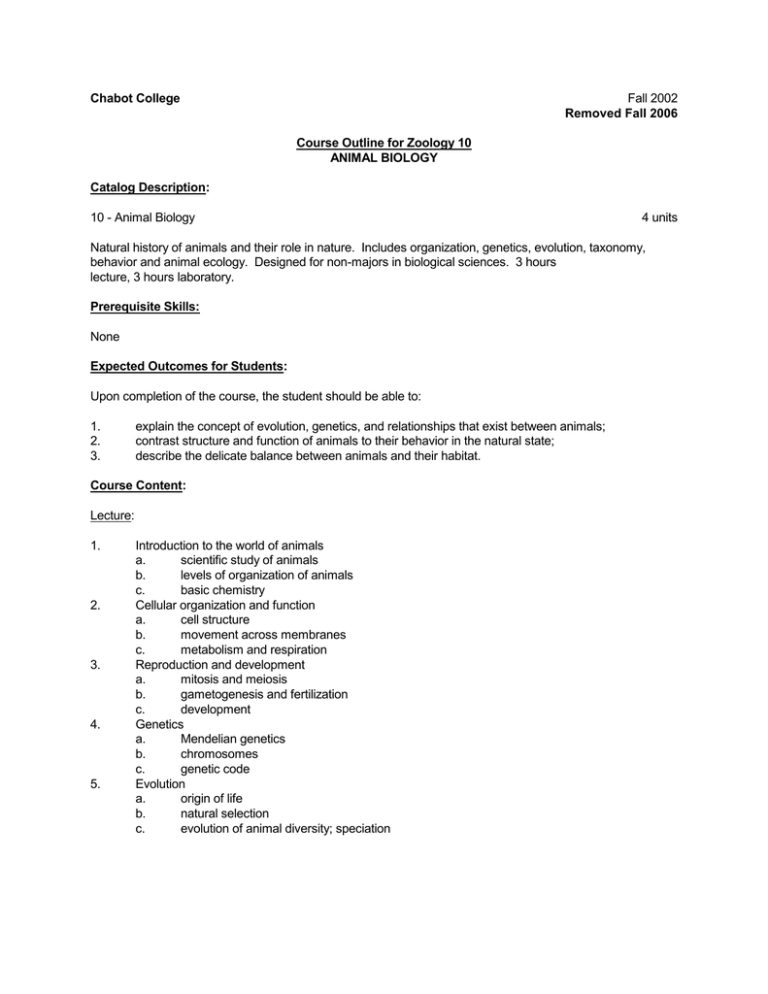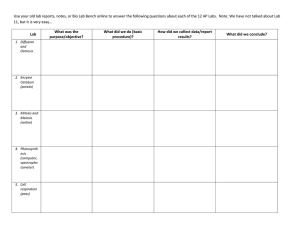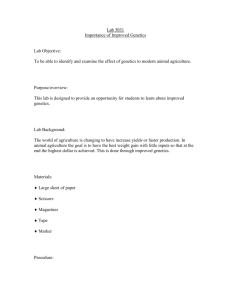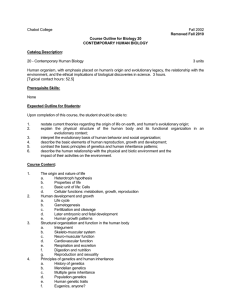Chabot College Removed Fall 2006 Course Outline for Zoology 10
advertisement

Chabot College Fall 2002 Removed Fall 2006 Course Outline for Zoology 10 ANIMAL BIOLOGY Catalog Description: 10 - Animal Biology 4 units Natural history of animals and their role in nature. Includes organization, genetics, evolution, taxonomy, behavior and animal ecology. Designed for non-majors in biological sciences. 3 hours lecture, 3 hours laboratory. Prerequisite Skills: None Expected Outcomes for Students: Upon completion of the course, the student should be able to: 1. 2. 3. explain the concept of evolution, genetics, and relationships that exist between animals; contrast structure and function of animals to their behavior in the natural state; describe the delicate balance between animals and their habitat. Course Content: Lecture: 1. 2. 3. 4. 5. Introduction to the world of animals a. scientific study of animals b. levels of organization of animals c. basic chemistry Cellular organization and function a. cell structure b. movement across membranes c. metabolism and respiration Reproduction and development a. mitosis and meiosis b. gametogenesis and fertilization c. development Genetics a. Mendelian genetics b. chromosomes c. genetic code Evolution a. origin of life b. natural selection c. evolution of animal diversity; speciation Chabot College Course Outline for Zoology 10, page 2 Fall 2002 Course Content: (continued) 6. 7. 8. 9. Taxonomy a. classification and phylogeny b. major animal phyla: 1) sponges 2) cnidarians 3) flatworms 4) roundworms 5) mollusks 6) segmented worms 7) arthropods 8) chordates Architectural patterns: comparative anatomy and physiology of animals a. feeding mechanisms and processing of nutrients b. gas exchange c. internal transport d. regulation of body fluids e. support and movement Animal behavior a. nervous coordination b. hormonal control c. principles of ethology d. communication e. social behavior Animal ecology a. populations b. communities c. ecosystems d. human impact on animal populations Laboratory: 1. 2. 3. 4. 5. 6. 7. 8. 9. 10. 11. 12. 13. 14. 15. 16. 17. Introduction to scientific method Microscopy Cytology Cell reproduction Animal development Genetics Natural selection Taxonomy Sponges, Cnidarians, flatworms, roundworms Feeding mechanisms and processing of nutrients Mollusks, segmented worms Gas exchange and internal transport Arthropods Chordates Support and movement Animal behavior Ecology Chabot College Course Outline for Zoology 10, page 3 Fall 2002 Methods of Presentation: 1. 2. 3. 4. Lecture and discussion Laboratory exercises Audio-visual materials Student projects and/or field trips a) Insect counts b) Charts of information to teach others Assignments and Methods of Evaluating Student Progress: 1. Typical Assignments: a. Preparation for lecture exam b. Preparation for comprehensive final c. Lab practicals d. Student project or term paper 1) Darwinian theory 2) Mendelian genetics 2. Methods of Evaluating Student Progress: a. Quizzes, midterms and final examination. b. Laboratory assignments and practicums. Textbook(s) (Typical): Biology: Concepts and Applications, Starr, Wadsworth Inc. Publishers, 2000 Special Student Materials: None. BC:al Revised: 2/13/02





